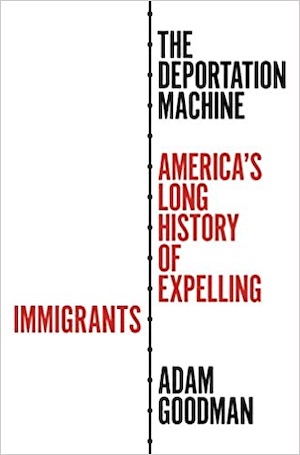By Paul Kiefer
At the end of the 19th century, the overwhelming need for cheap labor in the United States’ booming industrial sector was increasingly at odds with surging xenophobia in local and national politics. While employers recruited workers from Europe, Asia, and Latin America to fill factory floors, the federal government set about building an immigration bureaucracy with the exclusive power to admit, exclude, and expel immigrants.
But the nation’s anti-immigrant prejudices placed pressure on the new immigration bureaucracy to increase expulsions, so federal immigration officials adjusted. The results—both the system itself and the millions of people expelled from the country by various means since the late 19th century—are the subject of The Deportation Machine: America’s Long History of Expelling Immigrants by Adam Goodman, a professor of Latin American and Latino/a Studies at the University of Illinois at Chicago and a member of Phi Beta Kappa from Tufts University. “It was a tremendous honor,” he said of his ΦBK induction. “Dedication to a life of intellectual inquiry is at the heart of what I do, and it’s been as connected to my professional work as it is to my politics.” The book, he added, comes from the intersections between his personal, intellectual, and political passions.

Goodman traces the development of the “deportation machine” from its origins in the vitriolic anti-Chinese and anti-Southern and Eastern European campaigns of the late 19th century; through the criminalization of undocumented immigration and the scaling-up of formal deportations as the agricultural industry in the Southwest drew increasing numbers of migrant workers from Mexico in the early 1900s; and to the “era of mass expulsion” set off in the late 1970s by a simultaneous increase in arrivals from Mexico, economic downturn, and nationwide panic about undocumented immigration and overpopulation.
At the heart of The Deportation Machine, however, are Goodman’s efforts to cast light on the scale and human impact of mass expulsions, particularly for immigrants from Mexico, who made up 9 out of 10 immigrants deported between the end of the 19th century and the beginning of the 21st.
As he discovered during more than a decade of research, most people expelled from the United States were not formally deported; instead, the vast majority of the 57 million people expelled from the county since 1882 experienced a process often misleadingly called “voluntary departures,” which Goodman said have received little attention in earlier scholarship. “The term ‘voluntary’ is the misleading part,” he explained. “These expulsions occurred after an immigration agent apprehended someone and pressured or coerced them into signing a form waiving their legal rights to argue their case to stay in the country—and sometimes that involved forging an immigrant’s signature.” That strategy, Goodman noted, required less paperwork for immigration officials and carried a lighter penalty for the immigrant themselves: instead of spending time in a detention center awaiting a deportation hearing, they were expelled immediately.
Goodman describes that process as growing “increasingly punitive” over the course of the 20th century, casting a long shadow over immigrant (and, at times, U.S.-born) Mexican communities and repaying the workers on whom the United States relied with xenophobia and expulsions. But Goodman is also careful to acknowledge the resistance to the “deportation machine,” beginning with boycotts and lobbying campaigns by besieged Chinese communities in California in the late 19th century to the networks formed between labor organizers, lawyers, activists, and immigrants during the Chicano movement in the 1960s and 1970s. “Migrants themselves were always at the center of these struggles against the machine,” Goodman said. “They’re always keenly aware that the machine is vulnerable, and they’ve consistently tried to identify its weak spots. At no point have immigrant communities taken this treatment lying down.”
The Deportation Machine: America’s Long History of Expelling Immigrants was published in June 2020 and is available through Princeton University Press.
Paul Kiefer earned his bachelor’s degree in history from Pomona College, where he was inducted into Phi Beta Kappa in May 2020. Pomona College is home to the Gamma of California chapter of Phi Beta Kappa.




